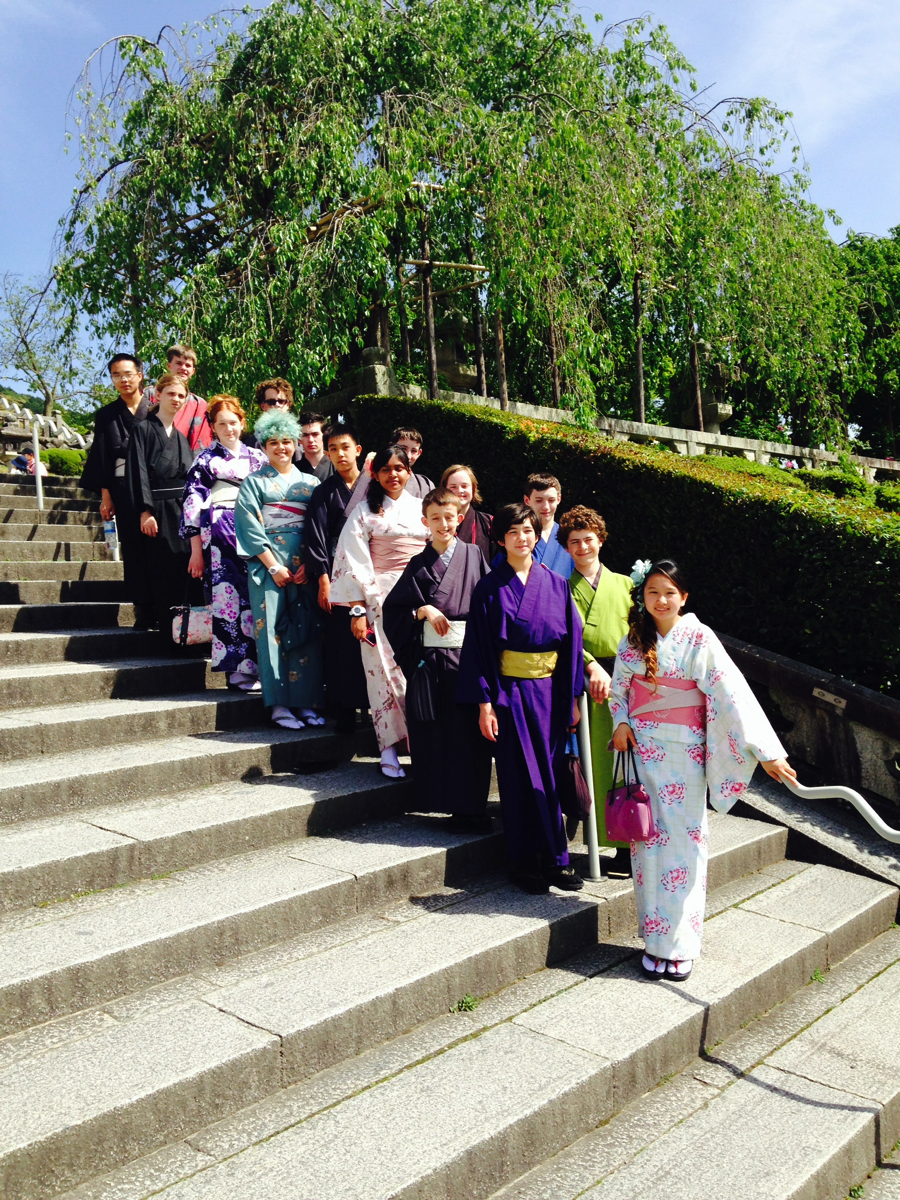Mountaineering Log Expedition Japan May 15, 2017 Latitude: 35 Degrees, 0 Minutes North (Kita) Longitude:…
Kyoto, Japan – May 2016
Mountaineering Log
Expedition Japan
May 11, 2016
Latitude: 35 Degrees, 0 Minutes North by
Longitude: 135 Degrees, 43 Minutes East
Weather: Clear Sky, W = NW at 12 Knots, T = 24 Degrees C.
Dear Parents,
I am writing this note to offer a brief report about the first week of our Japan Expedition. During this introductory leg, we sampled many of the historic sites in the Kyoto area – a topography chock full of majestic temples, shrines, and castles. The week was one of adjustment and orientation. Why, of course, our students were immediately homesick upon arrival but, by day # 3, the troupe finally acclimatized to their new reality and, I must say, the students have been quite incredible ever since. They have moved beyond their discomfort and disorientation and have successfully plunged into the Hero’s and Heroine’s Journey. The students will undoubtedly remember this educational adventure for the rest of their lives because the magnitude of impact will be formidable and consist of a portfolio of powerfully rich images, thoughts, memories, and feelings.
Our morning educational sessions always consist of 3 components. First, at check in, we ask the students to rate themselves with respect to how they are generally feeling. They use a simple 1 to 10 scale with a 1 meaning “terrible” and a 10 indicating “fabulous.” They also contribute one additional descriptor to help qualify the number they have selected. Today, all students reported numbers between 8 and 10, a sign that they have found a comfortable travel cadence. In fact, the lowest number submitted during the past 4 days has been a 7. During the first 3 days, many students reported numbers like 3 and 4. They are now acclimatized to the high altitude of international challenge and adventure.
Typically, during the second portion of the meeting, I take the time to cover the philosophical foundations of “The Inner and Outer Journey.” These are the 2 paths that all participants meander along while living out their expeditionary lives. So far, the more physical Outer Journey has been quite arduous. All students walk for hours every day and they also hustle to buses and scramble through hectic stations for local trains as they navigate around Kyoto. It is a real workout. The students take turns navigating through the city and its surrounds. This distributed leadership model ensures that all will share the responsibility of group guidance. Decoding signs, asking for directions in a foreign language, and herding our merry band is definitely fatiguing. Expeditionary theory suggests that students must experience some degree of physical pain if they are to gain the benefits of their expeditionary quest. This is sometimes called the principle of Sweat Equity and can be expressed by the simple mantra – “no pain, no gain!” Pain and sweat have a purifying impact on the body and students need to know they can endure both if they employ the power of mindset to disregard their distress. In a nutshell, the physical portion of the expedition is the outer journey of the body.
When the outer journey presents its excruciating impacts to each student’s body, the stage is set for the Inner Journey to begin. The removal from one’s home and family, the physical discomfort, and the spiritual and intellectual stimulation all serve to flip a toggle switch in the adventurer’s mind. This causes the hero and heroine to think more deeply while contemplating life, in general. During this inner passage of the mind, the voyager can set new goals and aspire to new dreams. Often true gratitude for one’s parents and family and authentic appreciation for home effervesce as the expedition continues through time and space. Finally, indebtedness to the other students who are sharing the same powerful experience also solidifies and a genuine loyalty to the team emerges. I suspect that the inner and outer journeys that have been recently inaugurated for all of our kids will expand in intensity during the coming weeks and it is a striking progression to bear witness to.
The third portion of a morning educational meeting is called Waypoints and Routes and consists of the extrapolation of the day’s educational events. The instructor-guides enthusiastically share their knowledge of Japanese history and culture and inspire students to look for various nuggets at the historical sites and sacred spaces visited. Meanwhile, Madeleine offers a comprehensive overview of Japanese language and encourages the students to converse as much as possible with native speakers.
The students are clearly embarking on their own individual Hero’s and Heroine’s Journey of self-discovery, a necessary event in their transition from childhood to young adulthood. This final Odyssey quest will punctuate a 3-year school experience and will take all Odyssians to Kyoto, Osaka, Hiroshima, Miyajima, and Sendai before delivering them to the base of Mt. Fuji where they will tackle one last summit together as a climbing team. I consider this journey to be an important inflection point in the lives of these students. If plotted on graph paper, the slope of both the learning line and independence line would angle up sharply for all of our sempai pupils during the next 3 weeks.
Right at this moment, the students are uncharacteristically quiet and reflective. At the deepest level, they all intuit that their days at Odyssey are quickly coming to an end. Simply put, it is time for them to move on to the next stage in their lives. Nonetheless all students want to prove to themselves, their parents, and their teachers that they are truly ready for the challenges ahead. I sincerely think that they are. In a month’s time, the Odyssey community will celebrate each student’s Rite of Passage. However, before we get there, all students have to succeed on the Road of Trials that the Japan quest is currently presenting. From my vantage point, I predict that this journey will be an outstanding learning adventure for all while also leaving positive indelible imprints in Odyssey’s historical book of accounts.
A paramount and fundamental ingredient in the alchemy of real expedition work is the element of removal. Most schools take their students on trips, not expeditions. Therefore, kids and parents email, Skype, and phone each other every 30 minutes. In order for Odyssey kids to grow and succeed in life, they sometimes have to leave their parents. Consequently, during the next 3 weeks, our third-year parents will be tested perhaps even more than our students because communication will be thin by design. I encourage any Odyssey parent to invite our third-year parents out for a glass of wine (or something stronger), as they just might need it. Expedition Japan is as much about parent growth as it is about student development. Stay safe in the coming weeks – and so will we!
Namaste,
Steveo
Climbing Sirdar
Doug-sensei, Lead Guide
Madeleine-sensei, Lead Guide
Aviva-sensei, Lead Guide
Postscript: Enjoy the photo, below!

